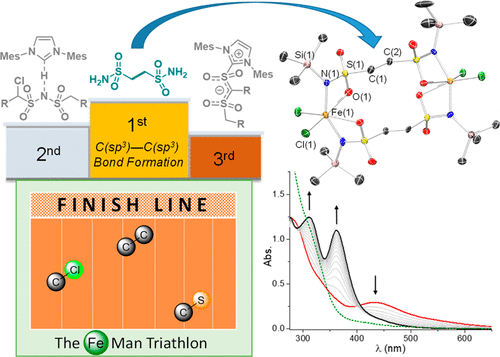当前位置:
X-MOL 学术
›
Organometallics
›
论文详情
Our official English website, www.x-mol.net, welcomes your feedback! (Note: you will need to create a separate account there.)
Unusual C–H Bond Activation and C(sp3)–C(sp3) Bond Formation at an Fe(II) Bis(amide) Carbene Complex
Organometallics ( IF 2.8 ) Pub Date : 2019-12-17 , DOI: 10.1021/acs.organomet.9b00674 Anthony Wong 1 , Kevin Guevara 1 , Guang Wu 1 , Gabriel Ménard 1
Organometallics ( IF 2.8 ) Pub Date : 2019-12-17 , DOI: 10.1021/acs.organomet.9b00674 Anthony Wong 1 , Kevin Guevara 1 , Guang Wu 1 , Gabriel Ménard 1
Affiliation

|
Treatment of (IMes)Fe(NTMS2)2 with 4 equiv of methanesulfonyl chloride (MsCl = MeSO2Cl) resulted in a complex reaction sequence involving substitution of two TMS groups for Ms, followed by the unexpected C(sp3)–H bond activation of Ms and subsequent C(sp3)–C(sp3) bond formation to generate the bimetallic Fe complex, [IMesH]2[Cl2Fe(N(TMS)SO2(CH2)2SO2N(TMS))2FeCl2] (1) (IMes = 1,3-bis(2,4,6-trimethylphenyl)-imidazole-2-ylidene; TMS = SiMe3). Extending this C–H activation/C–C bond-forming chemistry to larger alkylsulfonyl chloride chains (i.e., Et and Bu) similarly resulted in C–C coupling, but with decreased chemoselectivity. Detailed mechanistic studies, including using possible intermediate model compounds, were performed in order to elucidate a unifying mechanism for this previously unknown avenue to C(sp3)–C(sp3) bond formation.
中文翻译:

Fe(II)双(酰胺)碳烯络合物中异常的C–H键活化和C(sp 3)–C(sp 3)键形成
用4当量的甲磺酰氯(MsCl = MeSO 2 Cl)处理(IMes)Fe(NTMS 2)2导致复杂的反应序列,涉及用两个TMS基团取代Ms,然后是意外的C(sp 3)–H Ms的键活化和随后的C(sp 3)–C(sp 3)键形成,以生成双金属Fe络合物[IMesH] 2 [Cl 2 Fe(N(TMS)SO 2(CH 2)2 SO 2 N( TMS))2 FeCl 2 ](1)(IMes = 1,3-双(2,4,6-三甲基苯基)-咪唑-2-亚烷基; TMS = SiMe 3)。将此C–H活化/ CC键形成化学反应扩展至较大的烷基磺酰氯链(即Et和Bu)类似地导致C–C偶联,但降低了化学选择性。为了阐明这种以前未知的C(sp 3)–C(sp 3)键形成途径的统一机制,进行了详细的机械研究,包括使用可能的中间模型化合物。
更新日期:2019-12-18
中文翻译:

Fe(II)双(酰胺)碳烯络合物中异常的C–H键活化和C(sp 3)–C(sp 3)键形成
用4当量的甲磺酰氯(MsCl = MeSO 2 Cl)处理(IMes)Fe(NTMS 2)2导致复杂的反应序列,涉及用两个TMS基团取代Ms,然后是意外的C(sp 3)–H Ms的键活化和随后的C(sp 3)–C(sp 3)键形成,以生成双金属Fe络合物[IMesH] 2 [Cl 2 Fe(N(TMS)SO 2(CH 2)2 SO 2 N( TMS))2 FeCl 2 ](1)(IMes = 1,3-双(2,4,6-三甲基苯基)-咪唑-2-亚烷基; TMS = SiMe 3)。将此C–H活化/ CC键形成化学反应扩展至较大的烷基磺酰氯链(即Et和Bu)类似地导致C–C偶联,但降低了化学选择性。为了阐明这种以前未知的C(sp 3)–C(sp 3)键形成途径的统一机制,进行了详细的机械研究,包括使用可能的中间模型化合物。


























 京公网安备 11010802027423号
京公网安备 11010802027423号